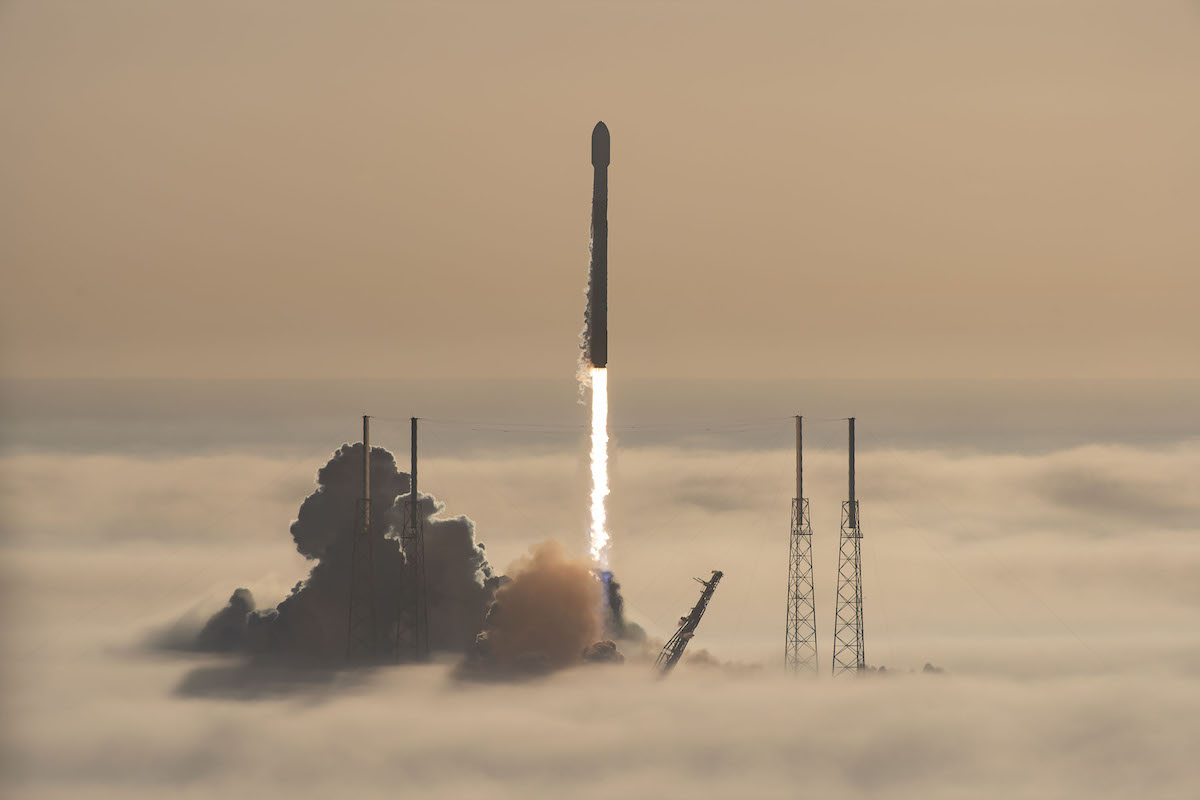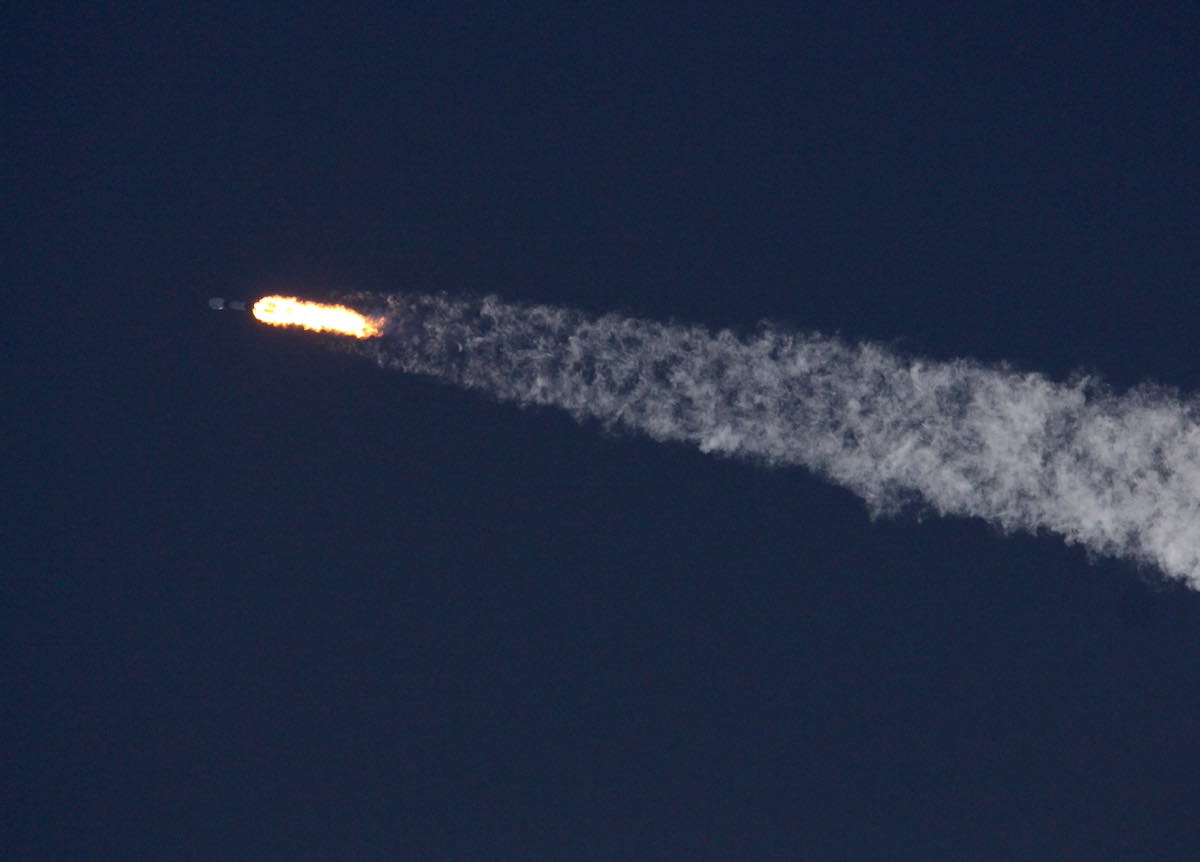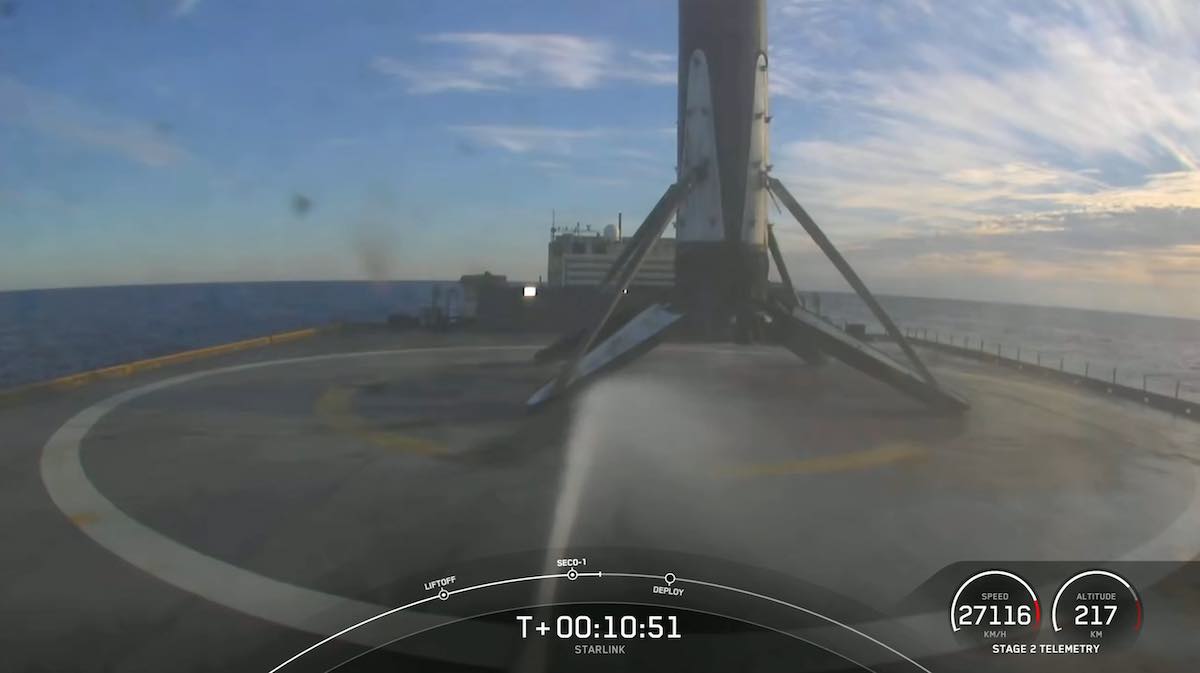
SpaceX shot 53 Starlink internet satellites into orbit on top of a Falcon 9 rocket Saturday from foggy Cape Canaveral, commencing a new phase of deploying the global broadband network with the first launch into a new “shell” some 335 miles above Earth.
The mission was the 31st Falcon 9 launch in two-and-a-half years dedicated to carrying satellites for the Starlink internet network, bringing the total number of Starlink spacecraft launched to 1,844.
Veiled in fog, the Falcon 9 lifted off from pad 40 at Cape Canaveral at 7:19:30 a.m. EST (1219:30 GMT) Saturday. Nine Merlin main engines throttled up to produce 1.7 million pounds of thrust, powering the launcher off the pad and quickly through the ground-hugging fog layer.
The two-stage, kerosene-fueled rocket rolled to line up with a flight path northeast from Florida’s Space Coast. The Falcon 9 arced downrange over the Atlantic Ocean, exceeding the speed of sound in about a minute.
The first stage shut down and separated about two-and-a-half minutes into the flight. While the booster stage descended back to Earth for landing, the Falcon 9’s second stage engine fired to propel the 53 Starlink spacecraft into orbit.
SpaceX showed views of the booster — designated B1058 in SpaceX’s fleet — falling back through the atmosphere. A landing burn using the rocket’s center engine slowed the vehicle down for an on-target touchdown on SpaceX’s drone ship “Just Read the Instructions” positioned east of Charleston, South Carolina.
The landing concluded the ninth trip to space and back for the booster, which debuted in May 2020 with the launch of astronauts Doug Hurley and Bob Behnken on SpaceX’s first crew mission. The historic launch ended a nine-year drought of orbital crew launches from U.S. soil.

The rocket’s upper stage burned its engine for six minutes to inject the Starlink satellites into orbit, shutting down just as the Falcon 9 booster landed in the Atlantic Ocean.
After coasting nearly seven minutes, the upper stage fired thrusters to go into a spin, setting up for release of the 53 Starlink satellites at about T+plus 15 minutes, 31 seconds.
A live camera view from the Falcon 9’s second stage showed retention rods jettisoning to release the flat-panel satellites as the rocket soared 141 miles (227 kilometers) over the North Atlantic Ocean.
The satellites were programmed to deploy solar panels to begin charging their batteries, then activate krypton ion engines to raise their orbits to an altitude of 335 miles (540 kilometers) to enter the Starlink fleet.
The mission Saturday, known as Starlink 4-1, was scheduled to take off Friday, but SpaceX kept the rocket on the ground an extra day due to storms near Cape Canaveral.
The launch capped a busy week for SpaceX.
The company’s Crew Dragon Endeavour capsule undocked from the International Space Station Monday to bring home a crew of four astronauts after nearly seven months in orbit. The spacecraft splashed down in the Gulf of Mexico Monday night to end SpaceX’s second operational crew mission to the space station.
Two days later, SpaceX launched a Falcon 9 rocket from pad 39A at NASA’s Kennedy Space Center Wednesday night with three NASA astronauts and one European Space Agency flight engineer. The four-person crew arrived at the space station Thursday to replace the astronauts that departed the complex earlier in the week.

The launch Saturday was the first to target a new orbital “shell” in SpaceX’s Starlink network at an inclination angle of 53.2 degrees to the equator.
Most of the Starlink satellites launched so far have deployed into a 341-mile-high (550-kilometer), 53-degree inclination orbit, the first of five orbital shells SpaceX plans to complete full deployment of the Starlink network. SpaceX finished launching satellites in that shell with a series of Starlink flights from Cape Canaveral from May 2019 through May of this year.
Since May, SpaceX has rushed to complete development of new inter-satellite laser terminals to put on all future Starlink satellites. The laser crosslinks, which have been tested on a handful of Starlink satellites on prior launches, will reduce the reliance of SpaceX’s internet network on ground stations.
The ground stations are expensive to deploy, and come with geographical — and sometimes political — constraints on where they can be positioned. Laser links will allow the Starlink satellites to pass internet traffic from spacecraft to spacecraft around the world, without needing to relay the signals to a ground station connected to a terrestrial network.
“Inter-satellite laser communications means Starlink can carry data at speed of light in vacuum all around Earth before touching ground,” tweeted Elon Musk, SpaceX’s founder and CEO. “Over time, some amount of communication can simply be from one user terminal to another without touching the internet.”
The completion of the first Starlink shell enables the network to provide high-speed, low-latency internet services to lower latitudes, such as the southern United States. The partial deployment of satellites into the first orbital shell initially provided service over northern regions of the United States, Canada, and Europe, as well as higher-latitude regions in the southern hemisphere.
SpaceX is currently providing interim internet services through the Starlink satellites to consumers who have signed up for a beta testing program.
Musk tweeted Saturday that the Starlink network should work for maritime customers by mid-2022, once SpaceX has launched enough laser-equipped satellites. “Until then, it will be patchy when far from land,” he tweeted.
SpaceX’s newest 53 Starlink internet satellites have deployed from the Falcon 9 rocket’s second stage in orbit.
SpaceX has launched 1,844 Starlink satellites to date.https://t.co/HsIOf3qPfu pic.twitter.com/FfVVC7bpc7
— Spaceflight Now (@SpaceflightNow) November 13, 2021
In September, SpaceX launched the first batch of 51 Starlink satellites into a 70-degree inclination orbit on a Falcon 9 rocket from Vandenberg Space Force Base. That orbital shell will eventually contain 720 satellites at an altitude of 354 miles (570 kilometers).
Aside from the 53-degree and 70-degree orbital shells, SpaceX’s other Starlink layers will include 1,584 satellites at 335 miles (540 kilometers) and an inclination of 53.2 degrees, and 520 satellites spread into two shells at 348 miles (560 kilometers) and an inclination of 97.6 degrees.
SpaceX has regulatory approval from the Federal Communications Commission for approximately 12,000 Starlink satellites. The company’s initial focus is on launching 4,400 satellites on a series of Falcon 9 rocket flights. SpaceX’s next-generation launcher, a giant rocket called the Starship that has not yet reached orbit, may eventually be tasked with launching hundreds of Starlink satellites on a single mission.
The launch Friday brought the total number of Starlink spacecraft SpaceX has launched to 1,844 satellites, including failed and decommissioned platforms, adding to the largest fleet ever put into orbit. It was the 31st dedicated Falcon 9 launch for the Starlink network.
SpaceX builds the Starlink satellites, each with a mass of about a quarter-ton, in a factory in Redmond, Washington.
A tabulation by Jonathan McDowell, an astronomer and respected tracker of spaceflight activity, shows SpaceX currently has 1,454 operational Starlink satellites, with nearly 100 additional craft moving into their operational positions in orbit.
Saturday’s launch was the 25th flight of a Falcon 9 rocket this year, but just the fifth of the second half of 2021. SpaceX launched 20 Falcon 9 missions from January through the end of June, a rapid launch cadence primarily driven by Starlink missions.
The pace has slowed since June as SpaceX struggled to finish development of Starlink’s inter-satellite laser terminals. SpaceX’s external customers also had no payloads ready to fly.
Three of SpaceX’s missions since June have carried Dragon capsules into space — crew and cargo missions for NASA to the space station, and the privately-funded Inspiration4 crew mission to low Earth orbit. The other two Falcon 9 launches since June have deployed Starlink satellites.
SpaceX has at least five more missions scheduled before the end of the year.
The next Falcon 9 launch will blast off from Vandenberg Space Force Base in California on Nov. 23 (California time) with NASA’s DART spacecraft, which will demonstrate a deflection technique that could protect Earth from a future asteroid impact threat.
At least four Falcon 9 missions are scheduled in December from Florida’s Space Coast, launching more Starlink satellites, NASA’s IXPE X-ray astronomy telescope, the Turksat 5B communications payload, and another NASA cargo mission to the space station.
Email the author.
Follow Stephen Clark on Twitter: @StephenClark1.
